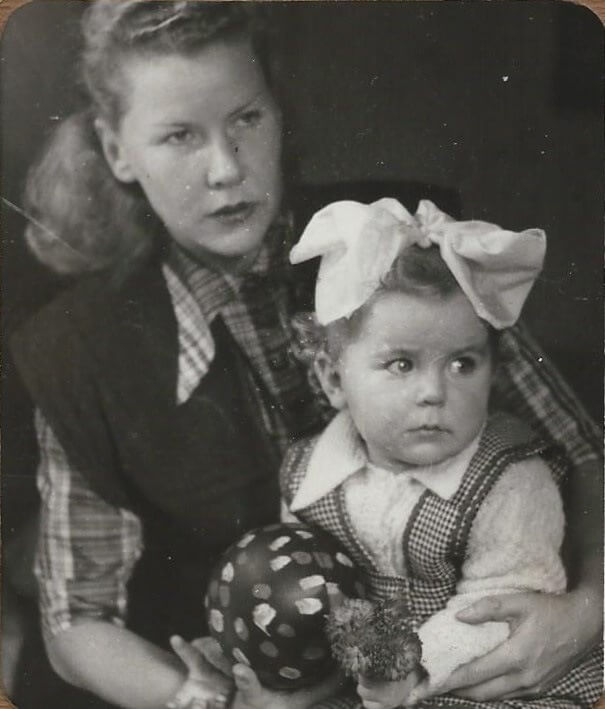Kaia Valge Fye is one of the people filmmaker Helga Merits had planned to interview in person last year for a documentary film about Seabrook Farms, but the coronavirus pandemic kept their plans at bay, with the filmmaker and her subject on different continents: Kaia in the United States, Helga in the Netherlands. Albeit with challenges, work on the film continues. The stories of Estonian refugees, their journeys, their past and present, need to be told.
Seabrook Farms was a food factory in New Jersey where some thirty nationalities lived and worked, amongst them some 600 to 900 Estonians, who came there after the war. They were, after the Japanese Americans, the second largest group. I continue to work on the film, despite the fact I still cannot visit the U.S. Kaia supports my work, as she thinks it is important the film should be made. Kaia grew up at Seabrook Farms. These are some of her memories: “I was two when I came to Seabrook Farms with my mother Helgi Valge from the Geislingen D.P. camp in Germany. The only thing I remember is getting sick on the boat to the U.S., but that is probably because they told me. We first lived for a short time at Hoover Village, rustic quarters built for the farm workers. Hoover Village was in bad shape, but then small houses were built, and most Estonians went to live there. Instead, my mother was hired as the maid at the house of the owner of Seabrook Farms, Mr C.F. Seabrook, so we moved into rooms at the Seabrook “mansion.”

My mom and I had two rooms at the Seabrook House. Next to the rooms was an attic and it was huge, and they kept a lot of furniture there, but also a lot of magazines. They subscribed to a huge variety of magazines, and they never got rid of the magazines. There were piles and piles. So as a child I had lots to read!
I would sleep in the guestrooms when nobody was there. I spent a lot of time reading in C. F. Seabrook’s library, because nobody came in there. The Seabrook House was my castle, and as a child I took advantage of all the fun stuff. For my mother it was hard. She worked long days serving the Seabrook family. I remember her toiling in front of the hot mangle iron in the laundry room.
The Seabrook’s had three sons and a daughter, Thelma. I was very good friends with Thelma’s daughter, Charlotte, and my mother was close to her too. Charlotte called my mother her second mum.
I have fun memories of my mother and I going to Wildwood Beach with Thelma and Charlotte.
My friends would often come to the Seabrook house. I had my birthday parties there in the big party room. We used to play there all the time with Charlotte and my friends. I played everywhere. I got more use of the house than most people, I think. There was a class distinction, but I did not let the class distinction bother me. I didn’t think of myself as a little servant kid. When Mr Seabrook died, I was even standing there with the family at the funeral. Nobody said anything, so it was fine with me.
All the years I lived there, from age two to eighteen, Mr Seabrook only said a few words to me and that was all. When I was fourteen he gave me a dollar or something. Mrs Seabrook was very smart, but I didn’t know her that well. I was a kid and then you don’t hang around with all the old people! My mother worked long hours for the Seabrook family, and I was left to fill time on my own. I was happy to hang out a lot with Charlotte and other friends.
One day I was at the pool and Eva Gabor was there, who dated C. F. Seabrook’s son Jack. She was famous, but I didn’t know that. I must have been around eleven years old. She was sitting on the pool deck and when I jumped in the pool the water splashed on her. The chlorine in the water turned her bleached blond hair green! She started screaming. I went into the house and just said: this crazy lady is screaming because her hair turned green. In the 1960s Eva Gabor starred in the TV comedy Green Acres, which took place on a rural farm. Eva Gabor used her experiences visiting Seabrook Farms as background for her role on the show.
Another time when I got away with mischief was when the boys at high school who had cars would be able to go to New York or Philadelphia to get away from the boredom of Seabrook, but of course I didn’t have a car and a lot of my friends didn’t have cars either. One day I “borrowed” C. F. Seabrook’s big car and just took off for a ride. I don’t remember getting punished, as they were probably so glad to just get the car back in one piece. A couple of years ago when I spoke to John Seabrook, C. F.’s grandson, he told me that the car I drove had been passed to him.
Sometimes the Seabrooks would have parties at the house. My mother and other Estonian women set up, cooked, and served at the parties. They had to wear uniforms: black ones for formal parties and white ones for informal. When my mother worked at the parties, I would have a friend, Ann Rooland, as my babysitter – she was only a little older than me. She didn’t really babysit me, because we both were just peering at all these people partying, all dressed up. When I grew older, the Seabrooks did not have big parties anymore. They had family gatherings, but not very often. Mrs. Seabrook was older, and parties somehow disappeared.
I felt mixed American-Estonian. I felt Estonian, because I went to Estonian school, Estonian camp and I had Estonian friends, but I also felt American. I was confirmed in the Estonian Lutheran Church but went on Sundays to the Historic Deerfield Presbyterian Church with my American friends. I don’t remember any other Estonians in the congregation. I even had two birthday parties. One was mostly for Estonians, and one was mostly for my American and Japanese friends. All were my classmates. We got on well together.
In those days the Seabrook Village Estonian House was the base for Estonian social and cultural activities. There were functions for adults and kids there almost every weekend. My piano teacher and good friend of my mother, Maimu Miido, led the wonderful Estonian choir, which performed in traditional Estonian costumes. Lia Heinla, another good friend of my mother, would direct the children in holiday plays. And of course all of us were active in Estonian scouting.
I was eighteen when we moved out of the Seabrook House. I wasn’t sad when I had to leave. All my fr1iends were there, but rural Seabrook seemed like the middle of nowhere. I had just graduated high school and Mr Seabrook had died without leaving any financial consideration for my mother after all her years of service for the family. My mother didn’t have a job when we had to leave Seabrook, so she took a course in dietetics and worked as a dietician at Bridgeton Hospital.
My mom also had many friends, but it was very hard for her being a single mother separated from the rest of her family. She never told me much of anything about her life before the war in Estonia and during the war in Germany before we came to Seabrook. She was born on the Sangaste Castle Estate, where my grandfather had been the head administrator for the German Count who owned the estate. Like so many other Estonians, the war disrupted and scattered my mother’s family. Her parents and sister emigrated to Sweden after the war, and her brother had stayed in Estonia. She never married my father. My mom told me she didn’t know about Seabrook until her friend Lia Heinla told her about it, and the next thing she knew, we were on the list to relocate there. She worked long hours and she never talked about the past, which was just too bad. When I was thirty-two after recovering from my first bout with cancer, I went to Estonia for a week, and I learned more about my family history from my grandmother than I had ever learned from my mother in all these years.
Some years ago, I drove around with a friend in Seabrook, but we couldn’t get into the Seabrook House because it is now a restricted substance recovery center. Maybe it was enough just to see it at a distance, as it is all in the past. But I keep in touch with friends from Seabrook, because I have lots of fond memories of the place.
My childhood was shaped by the unique experience of living in the Seabrook household between the privileged lives of the Seabrook family and the Estonians that labored for Seabrook Farms. My daughters recently established their Estonian citizenships, and I want them to have a better understanding of the Seabrook Estonian story. I hope the film about Seabrook Farms will be made, so they can see what I experienced there in the Seabrook community.”
Memories shared by Kaia Valge Fye
Helga Merits is a Dutch-Estonian journalist and documentary filmmaker. Among her many films are “The story of the Baltic University” and “Coming home soon – the refugee children of Geislingen”. She is now working on a film about Seabrook Farms, once one of the largest producers of frozen and canned vegetables. A large group of Estonians worked there.
















